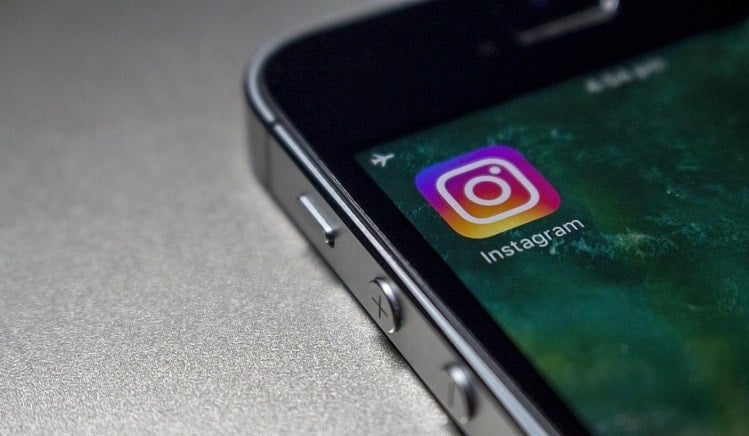Our Instagram database features data on 34 million Instagram profiles. Since it was built over time, it also contains deleted or inactive profiles. In this report we will only consider those profiles that are not deleted and have been active in the last 30 days. We will also restrict our analysis to profiles with 1,000 followers or more. We currently track 169,096 profiles that are in the beauty and cosmetics industry. Quick facts:
- 7,509 (4.44%) are private profiles
- 3,839 (2.27%) are verified profiles
- 111,189 (65.75%) have less than 10,000 followers (micro influencers)
- 9,782 (5.78%) have more than 100,000 followers (major influencers)
- the top two countries for this niche are United States and Italy
The first part of this report will present a descriptive analysis of the Instagram influencers belonging to the group of interest, while the second part will focus on some key metrics that can be of assistance to anyone looking to conduct influencer marketing campaigns on Instagram, especially for this niche.
Location
The geographical location of a profile is estimated by taking into account a variety of factors, like the biography of the profile, the posts and the location tags on each post. For the beauty and cosmetics niche, the profiles in our database are distributed according to the following choropleth map: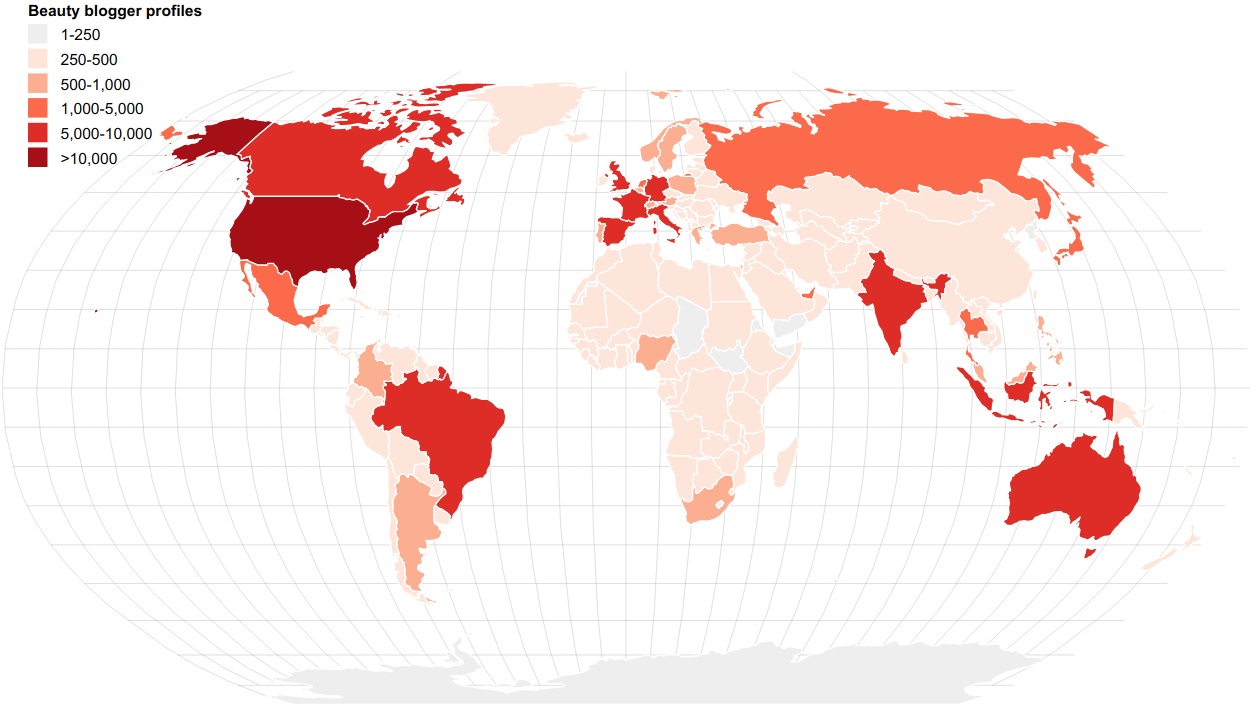 As can be seen in the image, the countries with the highest number of Instagram profiles in this niche are the Unites States, Italy and the United Kingdom. Right behind are Australia, Spain and France. In particular, we can focus on the profiles from the United States:
As can be seen in the image, the countries with the highest number of Instagram profiles in this niche are the Unites States, Italy and the United Kingdom. Right behind are Australia, Spain and France. In particular, we can focus on the profiles from the United States: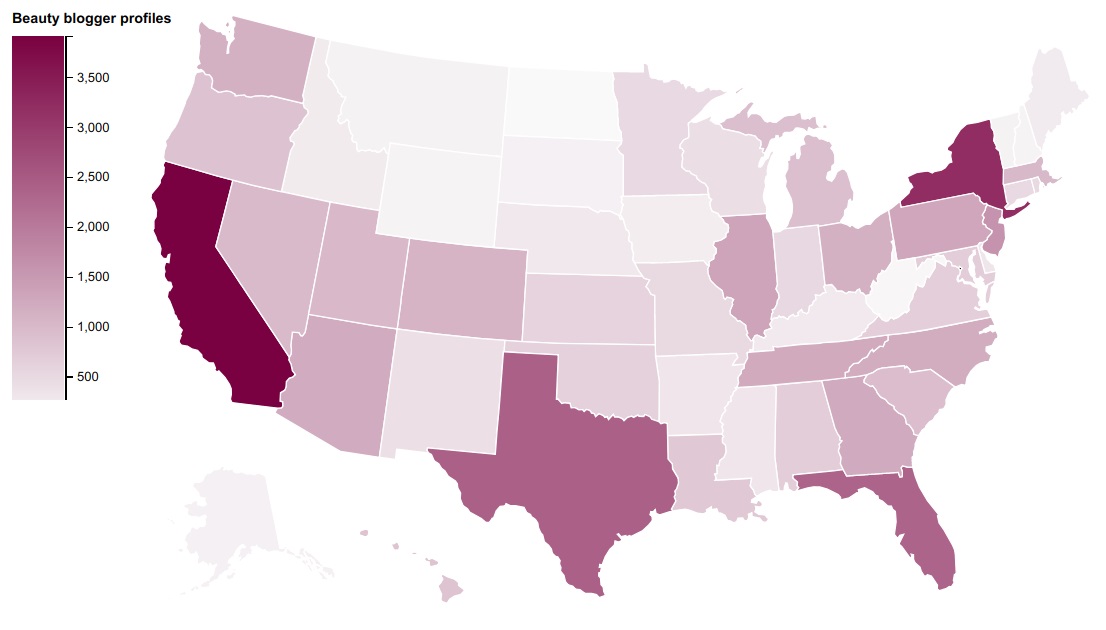 In this case, California, New York, Texas and Florida are by far the states with the most profiles in the beauty and cosmetics sector. Location data, together with the influencer’s posts and comments, can be used to infer the language spoken by those Instagram users (only official languages are considered):
In this case, California, New York, Texas and Florida are by far the states with the most profiles in the beauty and cosmetics sector. Location data, together with the influencer’s posts and comments, can be used to infer the language spoken by those Instagram users (only official languages are considered):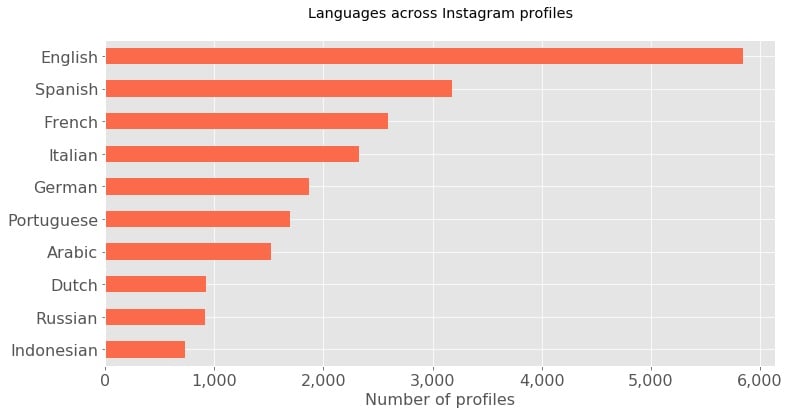
Posting frequency
The great majority of the profiles post a few times a week on average. One may wonder if major influencers post more than regular profiles. That is indeed the case: the biggest influencers post close to 8 times per week on average, while smaller profiles have an average of just 4 posts per week.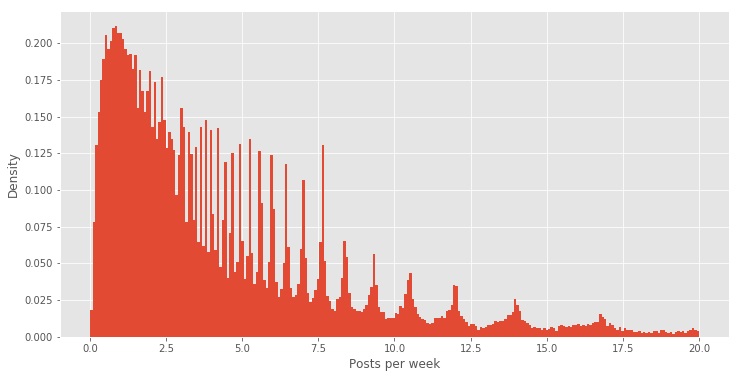
Followers and following
The distribution of the number of followers is incredibly skewed, so it’s very difficult to visualize it in a readable manner. This is true for social network profiles in general, but also for those in niches like the beauty and cosmetics one. This is because the great majority of profiles has a low number of followers (less than 1000), whereas there are profiles with hundreds of millions of followers. This is a difference of 5 orders of magnitudes. Thus, the only way to produce readable graphics is to use a logarithmic scale on the x axis: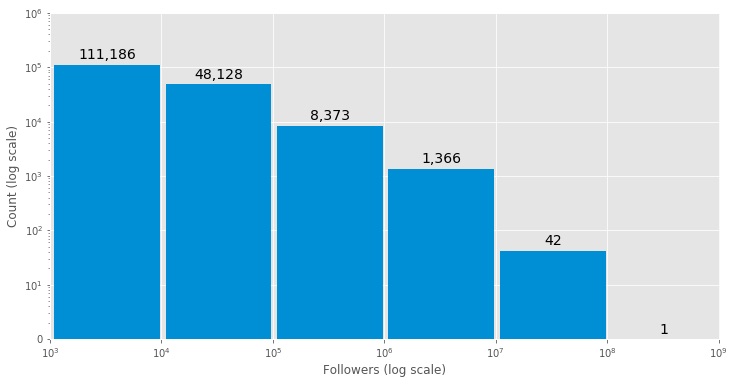 Another useful metric to gauge profiles is the ratio between the number of followers and the number of profiles one is following:
Another useful metric to gauge profiles is the ratio between the number of followers and the number of profiles one is following:![]() The ratio is very low if a person follows a lot of profiles while being followed by very few accounts. On the other hand, it’s very high for the so-called influencers, which have a big audience while at the same time following very few accounts. If the denominator is zero, the ratio is undefined. On average, Instagram accounts have 296 times more followers than following, but for verified profiles this ratio jumps to 17,910. Another important distinction is between micro and major influencers. We calculate that in the beauty and cosmetics niche, the average followers to following ratio for micro influencers is 22.2, whereas for major influencers it is 26846.1. The distributions are once again very much skewed: the median value for the former group is just 2.66 (meaning that half of the micro influencers have a follower to following ratio equal to or below 2.66, i.e. they can barely considered influencers) and there are profiles with very high ratios that contribute to a higher average value. For the major influencers, the median is 504.4; the distribution is similarly skewed. The 90% quantiles for the two groups are 14.5 and 12098.7
The ratio is very low if a person follows a lot of profiles while being followed by very few accounts. On the other hand, it’s very high for the so-called influencers, which have a big audience while at the same time following very few accounts. If the denominator is zero, the ratio is undefined. On average, Instagram accounts have 296 times more followers than following, but for verified profiles this ratio jumps to 17,910. Another important distinction is between micro and major influencers. We calculate that in the beauty and cosmetics niche, the average followers to following ratio for micro influencers is 22.2, whereas for major influencers it is 26846.1. The distributions are once again very much skewed: the median value for the former group is just 2.66 (meaning that half of the micro influencers have a follower to following ratio equal to or below 2.66, i.e. they can barely considered influencers) and there are profiles with very high ratios that contribute to a higher average value. For the major influencers, the median is 504.4; the distribution is similarly skewed. The 90% quantiles for the two groups are 14.5 and 12098.7
Engagement
Perhaps the single most important metric that can reasonably summarize an Instagram profile is the engagement rate. It is defined for each unit of content published by the profile (that is, each post) as the ratio between the sum of the number or likes and replies and the number of followers of the profile:![]() In the beauty and cosmetics niche, this is the distribution of the engagement rate across micro and major influencers:
In the beauty and cosmetics niche, this is the distribution of the engagement rate across micro and major influencers: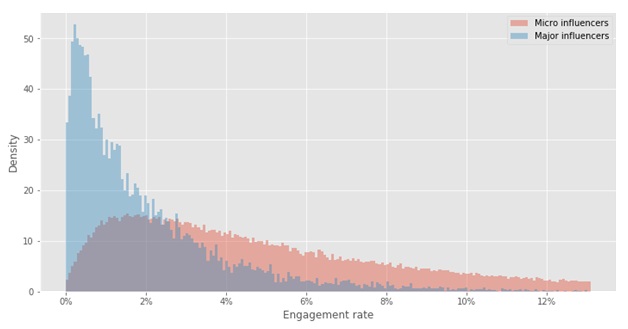 The engagement rate and the followers to following ratio are related, but their relationship is not as simple as a linear one, as the chart below illustrates:
The engagement rate and the followers to following ratio are related, but their relationship is not as simple as a linear one, as the chart below illustrates: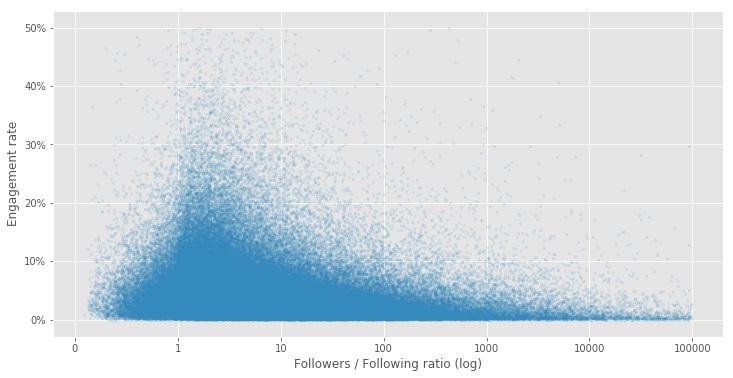 We can therefore conclude that the engagement rate can be used in combination with the followers to following ratio to evaluate Instagram profiles in the beauty and cosmetics niche.
We can therefore conclude that the engagement rate can be used in combination with the followers to following ratio to evaluate Instagram profiles in the beauty and cosmetics niche.
Engagement and posting frequency
We investigated whether posting frequency had a visible relation with engagement rate. Short answer: it does. In the scatter plot below, one can see that for beauty and cosmetics influencers the engagement tends to get lower as the posting frequency increases:
Profile quality
The engagement rate can be used as an indicator of profile quality and can produce some accurate results. In particular, it appears to be very good at pointing out which profiles don’t have genuine engagement. From the formula that defines the engagement rate, we can see that this rate can be above 1 if the sum of likes and replies exceeds the number of followers of a particular profile. This can happen for a fraction of the total posts of a profile (e.g. if one or two posts gain extreme popularity for some reason) but it cannot certainly be the norm, since the number of followers will balance out. Hence, for healthy profiles the engagement rate will be well below 1. This holds true both in general and for beauty and cosmetics influencers. In our database we also have profiles with an engagement rate in the hundreds or in the thousands
Images and videos
In the beauty and cosmetics niche, there is a noticeable difference in engagement between image posts and video posts, and the contrast is even more pronounced for major influencers.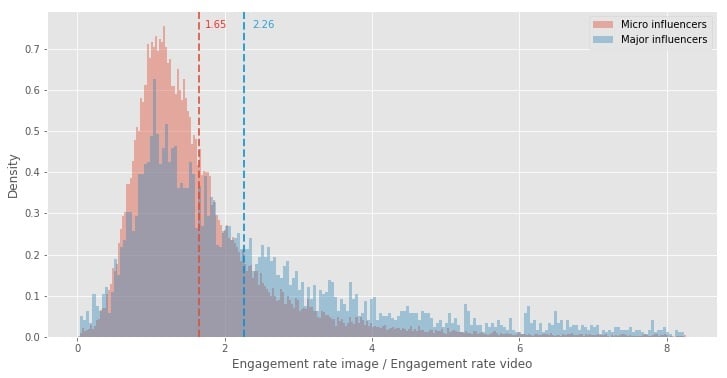 The chart above is fairly dense but very informative. It contains two different histograms, overlaid on the same axes, that display the distribution of the ratio between the engagement rate for image posts and the engagement rate for video posts. If one thinks that image posts have a higher engagement than video posts, then they would expect this ratio to be higher than 1. The chart confirms this belief. The methodology that we followed in order to produce such an image is the following: for each profile in our database we took the average engagement rate for image posts and the average engagement rate for video posts and we computed the ratio between them. Then we created the histograms above, which display the frequency of each value. The result is that, on average, for a micro influencer in this niche image posts have 1.65 times more engagement than video posts, while for major influencers this multiple increases to 2.26 times. Note: this is not to say that video posts have terrible engagement, but the conclusion is that with respect to image posts and as calculated by the formula above the engagement is lower for videos. This may be explained by the fact that the Instagram application itself facilitates the action of liking image posts over video ones. However, investigating systematic biases like that one is outside the scope of this post.
The chart above is fairly dense but very informative. It contains two different histograms, overlaid on the same axes, that display the distribution of the ratio between the engagement rate for image posts and the engagement rate for video posts. If one thinks that image posts have a higher engagement than video posts, then they would expect this ratio to be higher than 1. The chart confirms this belief. The methodology that we followed in order to produce such an image is the following: for each profile in our database we took the average engagement rate for image posts and the average engagement rate for video posts and we computed the ratio between them. Then we created the histograms above, which display the frequency of each value. The result is that, on average, for a micro influencer in this niche image posts have 1.65 times more engagement than video posts, while for major influencers this multiple increases to 2.26 times. Note: this is not to say that video posts have terrible engagement, but the conclusion is that with respect to image posts and as calculated by the formula above the engagement is lower for videos. This may be explained by the fact that the Instagram application itself facilitates the action of liking image posts over video ones. However, investigating systematic biases like that one is outside the scope of this post.
That is only one side of the coin: the engagement quality is also determined by replies and likes. For beauty and cosmetics influencers, the number of likes is much higher than the number of replies. In the beauty and cosmetics niche, on average the profile of a major influencer will have 177.6 times more likes than replies, while for micro influencers the multiple is lower at 40.9 times. Replies are usually considered stronger engagement than simple likes, so this should also be considered by those that have to decide which influencers to partner up with for sponsored campaigns
